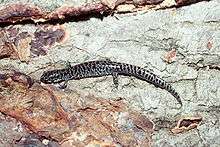Frosted flatwoods salamander
| Frosted flatwoods salamander | |
|---|---|
 | |
| Scientific classification | |
| Kingdom: | Animalia |
| Phylum: | Chordata |
| Class: | Lissamphibia |
| Order: | Caudata |
| Family: | Ambystomatidae |
| Genus: | Ambystoma |
| Species: | A. cingulatum |
| Binomial name | |
| Ambystoma cingulatum (Pauly, 2007) | |
The frosted flatwoods salamander (Ambystoma cingulatum) is a small (9-13.5 cm total length), elongated species of mole salamander. It has a small, indistinct head, short legs, and a long, rounded tail. Typical coloration consists of a background of brownish- to purplish-black overlaid with narrow gray or silvery-white reticulations (net-like markings), bands, or diffuse spotting. The gilled aquatic larvae are distinctly colored, having a series of bold brown and yellow longitudinal stripes.
The frosted flatwoods salamander has a very narrow geographic distribution, occurring only in the southeastern coastal plain of the United States. It inhabits seasonally wet pine flatwoods and pine savannas east of the Apalachicola River in northern Florida, southern South Carolina, and southern Georgia.[1] Prior to European settlement, it was most likely a common member of the fire-maintained longleaf pine (Pinus palustris)-wiregrass (Aristida spp.) community, which has since largely been replaced by urban development, agriculture, and pine silviculture. A recently published study documents the extirpation of a sizable breeding population as a result of a common silvicultural practice of converting natural pine forest to ditched and bedded slash pine plantation.[2] Further degradation of remaining frosted flatwoods salamander habitat has occurred as a result of the suppression of natural summer wildfires, allowing native ephemeral wetland communities to succeed to dense tangles of hardwood shrubs. As a result of these ongoing land use activities, populations are now extremely discontinuous and widely fragmented throughout the range as longleaf pine habitat is destroyed and degraded. It is currently restricted to a handful of remaining sites in Florida and Georgia, and has an especially tenuous presence in South Carolina.
The frosted flatwoods salamander breeds in small, shallow, ephemeral ponds, generally characterized by an overstory of pond cypress (Taxodium ascendens) and black tupelo (Nyssa sylvatica var. biflora) and a diverse understory of native grasses and herbs. Adult salamanders spend most of the year underground in burrows, especially those of crayfish, where they feed on a variety of small invertebrates. From September through December, adults migrate from surrounding upland habitats to their natal wetlands during rainfall events associated with passing cold fronts. Courtship presumably occurs within dry pond basins or very shallow water, where the female accepts a spermatophore that has been deposited on the substrate by the male. Females lay eggs in small groups, usually within clumps of moist vegetation or in the entrances of crayfish burrows in the dry pond basin. The eggs hatch in response to inundation by rising water levels in the pond basins. The larval period lasts about three months, with metamorphs leaving the breeding ponds in late spring. Sexual maturity is approximately one to two years for males and two to three years for females.
Conservation

The flatwoods salamander was listed as Federally Threatened by the US Fish and Wildlife Service in 1999, but populations continue to decline. When the species was separated into two species in 2007, the frosted flatwoods salamander and reticulated flatwoods salamander, the frosted flatwoods salamander maintained Threatened status while the reticulated flatwoods salamander (Ambystoma bishopi) was soon placed on the Federally Endangered list.[3]
References
- Means, Bruce, John G. Palis, and Mary Baggett. 1995. Effects of slash pine silviculutre on a Florida population of flatwoods salamander. Conservation Biology 10(2): 426-437.
- Palis & Hammerson (2004). "Ambystoma cingulatum". IUCN Red List of Threatened Species. Version 2006. International Union for Conservation of Nature. Retrieved 11 May 2006. Database entry includes a range map, a brief justification of why this species is vulnerable, and the criteria used.
- Pauly, Gregory, Oliver Piskurek, and Bradley Shaffer. 2007. Phylogeographic concordance in the southeastern United States: the flatwoods salamander, Ambystoma cingulatum, as a test case. Molecular Ecology 16: 415-429.
- Petranka, James W. 1998. Salamander of the United States and Canada. Smithsonian Institution Press, Washington, D.C. pp. 50–53.
External links
| Wikimedia Commons has media related to Ambystoma cingulatum. |
- Coastal Plains Institute. Research facility dedicated to the preservation of the herpetofauna characteristic of the Atlantic Coastal Plain including the Flatwoods Salamander.
- The Amphibian Foundation. A Conservation and Research Organization dedicated to the conservation of amphibians in the face of the global amphibian extinction crisis. The foundation, a partner on the federal Flatwoods Salamander Recovery Team, holds the only captive breeding colony of Frosted Flatwoods Salamander on the planet.
